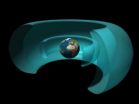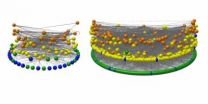Spices and herbs intervention helps adults reduce salt intake
American Heart Association Meeting Report
2014-03-19
(Press-News.org) Teaching people how to flavor food with spices and herbs is considerably more effective at lowering salt intake than having them do it on their own, according to research presented at the American Heart Association's Epidemiology & Prevention/Nutrition, Physical Activity & Metabolism Scientific Sessions 2014.
In the first phase of the study, 55 volunteers ate a low-sodium diet for four weeks. Researchers provided all foods and calorie-containing drinks. Salt is the main source of sodium in food.
In the second phase, half of the study volunteers participated in a 20-week behavioral intervention aimed at reducing their sodium intake to 1,500 mg/day by using spices and herbs. The other half reduced sodium on their own.
More than 60 percent of the participants in the study had high blood pressure, 18 percent had diabetes and they were overweight.
The researchers found:
In the first phase, sodium intake decreased from an average 3,450 mg/day to an average 1,656 mg/day.
In the second phase, sodium intake increased in both groups. But those who received the behavioral intervention consumed an average 966 mg/day of sodium less than the group that didn't receive the intervention.
"People in the intervention group learned problem-solving strategies, use of herbs and spices in recipes, how culture influences spice choices, how to monitor diet, overcoming the barriers to making dietary changes, how to choose and order foods when eating out and how to make low-sodium intake permanent," said Cheryl A. M. Anderson, Ph.D., M.P.H., lead author of the study and associate professor in the Department of Family and Preventive Medicine at the University of California San Diego.
Those assigned to the behavioral intervention group had cooking demonstrations and had a chance to share how they were changing traditional recipes to remove salt and include spices. The researchers didn't emphasize specific spices, and encouraged participants to try different things to find out what they liked most.
"Salt is abundant in the food supply and the average sodium level for Americans is very high — much higher than what is recommended for healthy living," Anderson said. "We studied the use of a behavioral intervention where people learn how to use spices and herbs and less salt in their daily lives."
"Given the challenges of lowering salt in the American diet, we need a public health approach aimed at making it possible for consumers to adhere to an eating pattern with less salt. This intervention using education and tasty alternatives to sodium could be one solution."
INFORMATION:
Co-authors are Laura K. Cobb, M.S.; Edgar R. Miller, M.D., Ph.D.; Mark Woodward, Ph.D.; Alex Chang, M.D., M.S.; Morgana Mongraw-Chaffin, Ph.D.; and Lawrence J. Appel, M.D., M.P.H. Disclosures are on the abstract.
The McCormick Science Institute funded the study.
For the latest heart and stroke news, follow us on Twitter: @HeartNews.
Statements and conclusions of study authors that are presented at American Heart Association scientific meetings are solely those of the study authors and do not necessarily reflect association policy or position. The association makes no representation or warranty as to their accuracy or reliability. The association receives funding primarily from individuals; foundations and corporations (including pharmaceutical, device manufacturers and other companies) also make donations and fund specific association programs and events. The association has strict policies to prevent these relationships from influencing the science content. Revenues from pharmaceutical and device corporations are available at http://www.heart.org/corporatefunding.
ELSE PRESS RELEASES FROM THIS DATE:
US women unfamiliar with most stroke warning signs
2014-03-19
Many U.S. women don't know most of the warning signs of a stroke, according to research presented at the American Heart Association's Epidemiology and Prevention/Nutrition, Physical Activity and Metabolism 2014 Scientific Sessions.
The study is also published in the American Heart Association journal, Stroke.
In a phone survey of 1,205 U.S. women:
More than half (51 percent) of the women identified sudden weakness or numbness on one side of the face, arms or legs as a warning sign of a stroke.
Less than half (44 percent) identified difficulty speaking or garbled speech ...
Researchers identify impaired new learning in persons with Parkinson's disease
2014-03-19
West Orange, NJ. March 20, 2014. Kessler Foundation scientists collaborated with colleagues in Spain to study memory and learning in patients with Parkinson Disease (PD). They found that the Parkinson group's ability to learn new information was significantly poorer when compared with the control group. The article was published ahead of print on February 24: Chiaravalloti ND, Ibarretxe-Bilbao N, Deluca J, Rusu O, Pena J, García-Gorostiaga I, Ojeda N. The source of the memory impairment in Parkinson's disease: Acquisition versus retrieval. Movement Disorders 2014 Feb 24. ...
Analysis: Industry-sponsored academic inventions spur increased innovation
2014-03-19
Industry-sponsored, academic research leads to innovative patents and licenses, says a new analysis led by Brian Wright, University of California, Berkeley professor of agricultural and resource economics.
The finding calls into question assumptions that corporate support skews science toward inventions that are less accessible and less useful to others than those funded by the government or non-profit organizations.
The analysis, based on a study of two decades of records from the University of California system, is in today's science journal Nature.
The National ...
NASA's Van Allen Probes reveal zebra stripes in space
2014-03-19
Scientists have discovered a new, persistent structure in one of two radiation belts surrounding Earth. NASA's twin Van Allen Probes spacecraft have shown that high-energy electrons in the inner radiation belt display a persistent pattern that resembles slanted zebra stripes. Surprisingly, this structure is produced by the slow rotation of Earth, previously considered incapable of affecting the motion of radiation belt particles, which have velocities approaching the speed of light.
Scientists had previously believed that increased solar wind activity was the primary ...
Sometimes less is more for hungry dogs
2014-03-19
Hungry dogs would be expected to choose alternatives leading to more food rather than less food. But just as with humans and monkeys, they sometimes show a "less is more" effect. Thus conclude Kristina Pattison and Thomas Zentall of the University of Kentucky in the US, who tested the principle by feeding baby carrots and string cheese to ten dogs of various breeds. The findings are published in Springer's journal Animal Cognition.
The research was conducted on dogs that would willingly eat cheese and baby carrots when offered, but showed a preference for the cheese. ...
Alzheimer's prevention trial to monitor reactions to higher disease risk status
2014-03-19
PHILADELPHIA - A new clinical trial will soon begin testing whether early medical intervention in people at risk for Alzheimer's can slow down progression of disease pathology before symptoms emerge, as outlined in Science Translational Medicine. For the first time, people with no Alzheimer's disease symptoms will be told of their risk status before being asked to join the randomized controlled trial. As part of the overall prevention trial, Penn Medicine neurodegenerative ethics experts will monitor how learning about their risk of developing Alzheimer's impacts trial ...
NJIT physicist helps to discover a new structure in Earth's radiation belt
2014-03-19
An NJIT physicist is a collaborator in the discovery of a new structure in Earth's inner radiation belt -- a zebra-striped structure of highly energized electrons that could endanger humans in space and also damage low-earth navigation and communication satellites.
And surprisingly, the new structure is produced not by solar activity but by Earth's slow rotation. Scientists had previously thought Earth's rotation couldn't affect the motion of radiation belt particles. The data supporting these discoveries comes from a measuring device aboard the two NASA Van Allen Probes ...
Scientists describe gut bacteria that cause sepsis in preterm infants
2014-03-19
Researchers studying intestinal bacteria in newborns have characterized the gut bacteria of premature infants who go on to develop sepsis, a serious and potentially life-threatening condition caused by bacteria in the bloodstream. Their findings suggest new strategies for the early detection and prevention of severe bloodstream infections. The research was funded by several components of the National Institutes of Health (NIH)—the Eunice Kennedy Shriver National Institute of Child Health and Human Development (NICHD), the National Human Genome Research Institute (NHGRI), ...
Ancient food webs developed modern structure soon after mass extinction
2014-03-19
Researchers from the Santa Fe Institute and the Smithsonian Institution have pieced together a highly detailed picture of feeding relationships among 700 mammal, bird, reptile, fish, insect, and plant species from a 48 million year old lake and forest ecosystem.
Their analysis of fossilized remains from the Messel deposit near Frankfurt, Germany, provides the most compelling evidence to date that ancient food webs were organized much like modern food webs. Their paper describing the research appears online and open access this week in Proceedings of the Royal Society ...
NIH grantees sharpen understanding of antibodies that may cut risk of HIV infection
2014-03-19
What immune response should a vaccine elicit to prevent HIV infection? Two studies published online today bring scientists closer to answering this question by identifying previously unrecognized attributes of antibodies that appear to have reduced the risk of HIV infection in the only clinical trial to show efficacy, albeit modest, of an experimental vaccine regimen in people.
Earlier analyses of the results of that trial, known as RV144, suggested that antibodies to sites within a part of the HIV envelope called V1V2 correlated with reduced risk of HIV infection. These ...
LAST 30 PRESS RELEASES:
Scientists uncover 95 regions of the genome linked to PTSD
AI tool predicts responses to cancer therapy using information from each cell of the tumor
CEOs’ human concern translates into higher stock price
Smoking-related deaths could be reduced if people attending lung cancer screening are offered stop-smoking support
Quick decisions in soccer enhanced by brain’s ability to suppress actions
Recycling CFRP waste is a challenge, but we've found a way to make it work
Advanced nuclear magnetic resonance technique developed to reveal precise structural and dynamical details in zeolites
Advancing performance assessment of a spectral beam splitting hybrid PV/T system with water-based SiO2 nanofluid
Researchers realize target protein stability analysis by time-resolved ultraviolet photodissociation mass spectrometry
Oxygen vacancies mediated ultrathin Bi4O5Br2 nanosheets as efficient piezocatalyst for synthesis of H2O2 from pure water
Warming and exogenous organic matter input affected temperature sensitivity and microbial carbon use efficiency of agricultural soil respiration on the Qinghai-Tibet Plateau
Eco-friendly glue designed by Cal Poly, Geisys Ventures team earns industry 'Innovation Award'
From dreams to reality: unveiling the ideal in situ construction method for lunar habitats and paving the way to Moon colonization
From theory to practice: Study demonstrates high CO2 storage efficiency in shale reservoirs using fracturing technology
What women want: Female experiences to manage pelvic pain
Study finds ChatGPT shows promise as medication management tool, could help improve geriatric health care
Heart failure, not stroke is the most common complication of atrial fibrillation
Antipsychotics for dementia linked to more harms than previously acknowledged
Health improvements occurred worldwide since 2010 despite COVID-19 pandemic, but progress was uneven
Mind the gender gap – Met police least trusted by women
Surrey engineers help Mauritius spot illegal fishing from space
Opioid dependence remains high but stable in Scotland, new surveillance report finds
Protecting brain cells with cannabinol
Calorie restriction study reveals complexities in how diet impacts aging
Atom-by-atom: Imaging structural transformations in 2D materials
How 3D printers can give robots a soft touch
Rice alumna wins prestigious merit-based fellowship for new Americans
International group runs simulations capable of describing South America's climate with unprecedented accuracy
Researchers find that accelerated aging biology in the placenta contributes to a rare form of pregnancy-related heart failure
Vibrations of granular materials: an everyday scientific mystery
[Press-News.org] Spices and herbs intervention helps adults reduce salt intakeAmerican Heart Association Meeting Report


